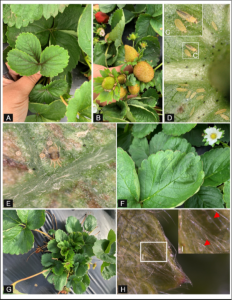Dr. Sriyanka Lahiri, Assistant Professor of Entomology

This strawberry season, the majority of strawberry leaf and fruit samples sent to my lab from strawberry growers in Florida for pest identification had damage from chilli thrips, Scirtothrips dorsalis Hood (Thysanoptera: Thripidae) (Fig. 1A-D) Some also had twospotted spider mite, Tetranychus urticae Koch (Arachnida: Acari: Tetranychidae) (Fig. 1E-F) damage. Chilli thrips were found in strawberry (cultivar Brilliance) research plots at GCREC in as early as the first week of October 2019. The results of insecticide efficacy trials sponsored by several industry partners showed that 20 days after treatment (DAT), Radiant® SC Insecticide (spinetoram, IRAC #5), Exirel® @ 20.5 fl. oz. (cyantraniliprole, IRAC#28), Apta® (tolfenpyrad, IRAC # 21A), and Minecto® Pro (abamectin + cyantraniliprole, IRAC #6+28) suppressed chilli thrips adults significantly. Also, at 20 DAT, only Radiant® SC Insecticide and Exirel® (high rate @ 20.5 fl. oz.) suppressed chilli thrips nymphs (juveniles) significantly. Plots receiving Radiant® had significantly high marketable fruit yield compared to all other insecticide treatments.
Results indicate that Radiant® showed promising control of both adults and nymphs with significantly high marketable fruit yield. After Radiant®, Exirel® at high rate, showed promising control of both adults and nymphs. Therefore, Exirel® can be rotated in a strawberry spray program to reduce the selection pressure on insect pests. Sivanto™ prime has also shown good suppression of adult chilli thrips. No phytotoxicity was observed from any insecticidal products. However, some strawberry growers reported that there was no effective suppression of chilli thrips even after application of Radiant® twice in the season. It must be considered that most products suppress the adult chilli thrips, but not the nymphs. Rimon® 0.83 EC (novaluron, IRAC # 15) on the other hand, suppresses nymphs only. Tank mix limitations of products that suppress thrips adults only and those that suppress thrips nymphs should be checked before combining products for field application. Also, products enlisted above should not be applied more than two times in a season, even as part of a rotation.
Greenhouse studies at GCREC using organic pesticide Captiva® Prime showed effective suppression of adult chilli thrips, but not of the nymphs. On the other hand, the generalist predatory mite, Amblyseius swirskii Athias-Henriot (Arachnida: Mesostigmata: Phytoseiidae) was found to be effective in suppressing nymphs of chilli thrips and is now a serious candidate to be tested in open-field experiments during our next strawberry season.
Early season worms were easily managed by weekly application of Dipel® DF Biological Insecticide.
During early to mid-February 2020, some strawberry fields in Plant City and Summerfield reported a spike in cyclamen mite, Phytonemus pallidus (Banks) (Arachnida: Acari Tarsonemidae) (Fig. 1G-I), infestations which was followed with twospotted spider mite and chilli thrips infestations. Cyclamine mites and eggs were found hiding under the calyx of the fruit, were miticides cannot reach easily. Samples were collected and pest identification was done in my lab. Portal® (fenpyroximate, IRAC #21A) provided most effective cyclamen mite suppression. It must be noted that miticides labeled for twospotted spider mites may not be labeled for cyclamen mites. For example, both Portal® and Agri-Mek® SC Miticide (abamectin, IRAC # 6) are labeled for cyclamen mites but Nealta® (cyflumetofen, IRAC # 25) is not.
Following the trend of the past few years, releases of predatory mite, Phytoseiulus persimilis Athias-Henriot (Acarina: Phytoseiidae) for twospotted spider mite management was done this year too.
 1
1
